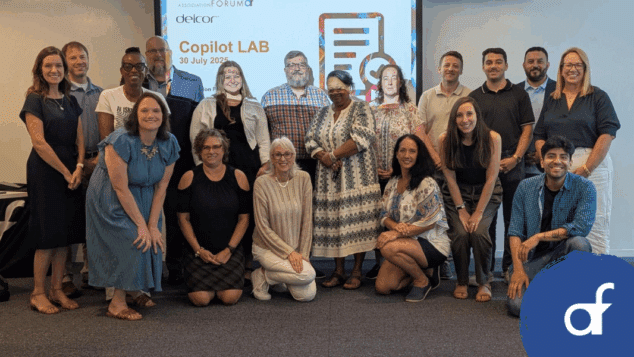Tackling Tech

If one thing is certain in this modern digital age, it’s this: The pace of technology is not slowing down anytime soon. As the number of users, programs, platforms and tools continues to grow exponentially, the only option for any kind of business is to get on board or risk becoming irrelevant.
It’s no secret that, for some associations, staying current on technology is a struggle. Whether it’s because of frequently changing leadership, a shortage of IT resources or a lack of agility, keeping up to date can seem daunting.
But to deliver real value to members in today’s ever-evolving digital world, staying technologically relevant is not just a value-add — it’s a necessity.
“Our members are more sophisticated, and they expect us to act and provide the same 24/7, mobile, personalized experiences that other subscription, product or service companies provide. Often, they expect us to provide a ‘concierge’ experience due to the exclusive nature of our relationship,” says Simona Rollinson, chief technology officer at global technology association ISACA, headquartered in Schaumburg, Illinois.
“Changing a Tire at 60 mph”
If technology’s importance is indisputable, why do some associations have trouble keeping up? Experts agree that the sheer speed of all the advancements makes it easy to fall behind.
“As the pace of technology change is increasing, the pace of software and hardware end-of-life exceeds the velocity in which organizations can change,” Rollinson says.
Associations tend to accumulate “technical debt” since their average lifespan is longer. This means that not only do associations have to keep up with the new and expanding expectations of their members, but also upgrading legacy systems.
“‘Changing a tire at 60 miles per hour’ is how I refer to this fragile balance,” Rollinson says.
Another hurdle that can prevent technological advancement is changing leadership roles. When these roles change so often in associations, it can be difficult to stay on top of change management and technology.
Lastly, associations may lack the adequate resources to address a dearth in technology, says Dan Hickey, strategic consultant, technology management for Chicago-based tech consultancy DelCor Technology Solutions.
“Technology evolves so quickly right now, and many associations struggle to find the right people in tech roles to facilitate that,” he says. “You can’t just have an IT department focusing on technology anymore — all staff use a variety of digital technologies. They don’t have to be experts, but the entire organization needs to embrace and understand the role technology plays in their association.”
It’s important to keep in mind that technology isn’t just about adopting the latest tools and shiny gadgets. It’s about streamlining your processes, improving efficiency, enabling your staff to work from anywhere and delivering the most value to your members, who are growing increasingly hungry for new, personalized experiences.
“The old adage that ‘every company is a technology company’ has never been truer than it is now. Technology is no longer about networks and email — it is about business enablement and disruptions to business models,” Rollinson says. “We need to continuously reimagine ourselves so we stay relevant. As costs and barriers to technology-driven innovation decrease, the speed of business change continues to accelerate, and new/unknown competitors enter the scene.”
The longer an association waits to address technology, the more complicated it becomes, says Jim Young, co-founder and CEO of Realcomm, a San Diego-based digital media and events company focused on technology, innovation and operations for the commercial real estate industry.
“If you’ve ignored it for three to five years, it will probably be way too much to jump into,” he says. “Eventually, it just gets too complicated, and the association will struggle greatly.”
If you feel that your association is struggling, then it is time to get to work.
Addressing the Problem
How can an association begin to evaluate its technological shortcomings? The first thing to do is to admit to and identify any weaknesses.
“They must first admit, out loud, how far behind they truly are,” Young says. “Especially at the senior level, folks have to admit that they are not experts in technology and that their lack of expertise may have allowed the association to fall behind.”
The next thing to do is to stop thinking of technology as just an IT problem. It is a business problem and must be addressed that way.
“Ensure the ongoing success of the technology rationalization and investment effort by gaining the active engagement and leadership of business executives, and get a seat at the table,” Rollinson says. “Also, change the focus of rationalization of technologies and platforms from an IT initiative to a business initiative by focusing on business process standardization.”
Hickey agrees that without the buy-in from all of an association’s leadership, any new technology will be dead on arrival.
“It’s very rare for any kind of significant technology improvement to come from the bottom up,” he says. “It has to first be embraced at the top. This will then trickle down throughout the organization. If the top prioritizes a technology initiative, it’s easier for everyone else to get on board.”
Outside Help
Once you assess your location on the tech spectrum, it’s time to get some help. Since most associations won’t be able to adequately address their technology issues internally, it’s a good idea to hire an outside consultant.
Look for a consultant who not only knows the tech space, but also knows how associations work, Young says.
“Associations are unique entities, so you want a consultant who understands your association’s specific goals and needs,” he says.
He also advises against assembling a member-based tech committee to lead the charge. It’s too late to tackle it internally, he says, and members won’t move as quickly as a consultant will. On top of that, it’s difficult for internal teams to openly and honestly review their own skill sets.
A consultant will not only be able to implement change faster but will also stay objective. Because of that, he or she will be able to more clearly outline a plan that is aligned with your business strategy.
Looking to the Future
If you want your business to move forward technologically, so too should your staff. When you interview potential new employees, ask them about their tech competency. Make sure that all new hires have the aptitude to work with the digital tools that are becoming commonplace, Hickey says. “Everyone uses it, it’s not going away, so all of your employees should have a solid foundation in working with technology,” he says. “The more people who understand it and use it, the better.”
Keeping those employees happy and engaged means empowering them to work from anywhere at any time on any device. To recruit the best talent, and to improve efficiency association-wide, implementing a telecommuting policy is critical.
“Given the circumstances surrounding the coronavirus, the entire world has had a 30-day crash course on digital transformation,” Young says. “Organizations all over the world have told their staff to work from home, and videoconferencing has become the norm for kindergarteners to CEOs. Can your association handle that? If you’re still running your organization like you did 30 years ago — expecting people to come into the office every day — you can’t be competitive anymore.”
Also going forward, you should become more focused on data. As an organization, you’re undoubtedly collecting data on any number of things, including your members and your marketing efforts. Do you have the knowledge and expertise to make meaningful decisions from that data?
“We see associations sit on loads of data yet don’t know whether to make heads or tails of it,” Hickey says. “But all that data is information you can use to answer important business questions and grow your association.”
Growing Pains
As you build your tech toolkit, keep in mind that there may be some hiccups as you get started. Some of the tech you implement may not be a perfect fit. Some employees may be resistant to adopting new technology. And some old habits might be hard to break. But it is worth all of the trial and error.
“Often the thought is to just ‘throw technology at it and things will get better,’” Rollinson says. “But in my experience, this approach never works without equal, if not more, attention to both people and process. The three-legged stool is ‘people, process, technology.’ You can’t balance on only two of these legs.”
While hiring a consultant, buying new technology and replacing legacy systems will cost money, the cost of not doing it could be devastating, Young says.
“Failing to invest the time and resources in tech these days is not an option,” he says. “Associations that have been kicking the can down the road are about to run out of time. They have no choice but to catch up or get crushed.”
Fortunately, by taking the appropriate steps, you won’t have to make that choice.
![]() Transforming for the Digital Revolution Featuring Simona Rollinson as keynote speaker, Association Forum’s SmartTech Conference® 2020 will provide you with all of the tools and expert advice you need to modernize your association’s technology plan. Sign up and learn more at associationforum.org/events/smarttech2020.
Transforming for the Digital Revolution Featuring Simona Rollinson as keynote speaker, Association Forum’s SmartTech Conference® 2020 will provide you with all of the tools and expert advice you need to modernize your association’s technology plan. Sign up and learn more at associationforum.org/events/smarttech2020.
Tags
Related Articles
Turning AI Into Member Value
How AAE’s Save Your Tooth Month GPT became a personalized marketing assistant for members
The Power of Taking the AI Journey Together
Forum’s first Microsoft Copilot Lab brought together 20 professionals to explore how smart adoption of...
Protecting Healthcare: Tackling Cyber Threats to Hospitals and Patients
The critical role of cybersecurity in healthcare and association management.




